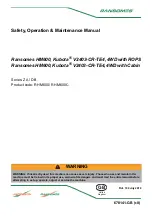
1 - 11
z
Check the horizontal and vertical permissible load of the hitch (or drawbar) before towing. The load
is different with trailer brake, and stopping distance increases with speed and weight of towed loads
and slope. Make sure you consider the total weight of the equipment and its load. (
See section 4.
“Hitch and Drawbar”
)
z
Drive slowly when towing extremely heavy loads.
z
Do not tow trailers that are not fitted with an independent braking system.
(5) Notices when towing the tractor
z
If your tractor needs to be towed for a short
distance, use the hitch (or drawbar) or front
towing hook. Do not connect to other structures
such as rear axle, ROPS, front axle, steering
components for towing.
z
Tractor can be steered for a short distance
without engine running, but it will be hard to turn
the steering wheel. If possible, run the engine for
steering and lubrication.
z
When being towed, disengage the 4WD,
differential lock, parking brake and place all gear
shift levers in neutral position.
(6) Notices when transporting the tractor
z
When transporting the tractor by truck, trailer,
etc, use suitable equipment or facilities to
load or unload the tractor.
z
Fix the tractor tightly to the vehicle with heavy-
duty straps or chains.
z
When fixing the rear of the tractor, use the hitch
or hitch support.
z
When fixing the front of the tractor, use the
towing hook.
z
When driving on public roads, the transporting
vehicle must have signs and lights required by
local regulation to avoid collision with a vehicle.
▶
When fixing the tractor, do not hook or connect chains to the 4WD shaft, steering
cylinder, tie-rod or front axle. These can be damaged by the chain or excessive
strain.
▶
In case of turbocharger engine (where fitted), cover the exhaust outlet to protect
that the turbocharger does not rotate by air without lubrication.
Caution














































